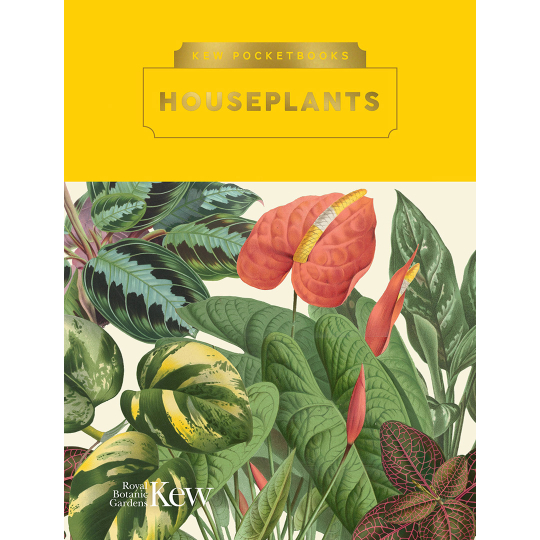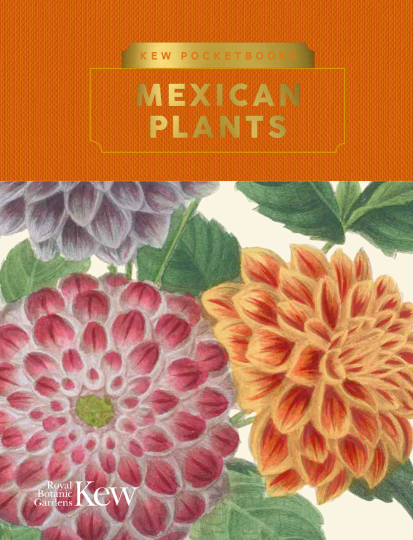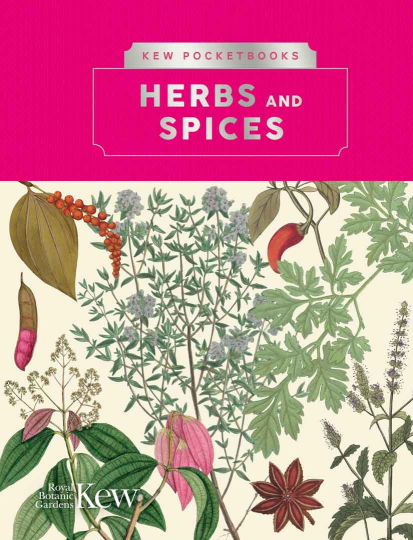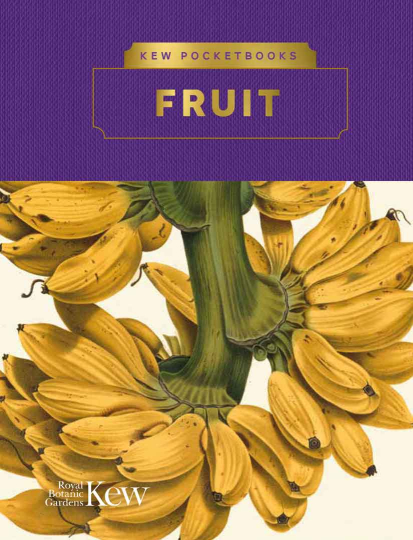Having presented an overview of the Kew Pocketbook series of illustrated plant books in the previous post, this post – and the following one [Part 3] – looks in more detail at eight of the titles in that series.
By way of a general comment for the four titles considered in this post, none of them have any explicit indication of the sources for statements of fact made in the Introduction or the annotations to the illustrations. Onto this post’s quartet of titles…
Houseplants, 2024.

Introduction by Kew horticulturalist Brie Langley, and curated by Langley and Lydia White.
Houseplants “is a celebration of the integration of plants into our living spaces”. In the Introduction Langley gives much-needed (and -appreciated!) words of encouragement to all would-be plant carers. And she tells us that the 40 plants selected for this volume were chosen “to suit all levels of experience, available time, and budget” (p. 6). The Introduction is chock-full of useful hints on plant care, and cultural notes – that’s notes on how to grow and cultivate them not their ethnobotanical associations – accompany each plant to ensure your living examples live their best life [even though that be inside, in a house, hundreds of miles from their natural home]. All of this is presented with a lovely writing style, which one would like to read more of. In some respects this title reminded me of David Gerald Hessayon’s ‘Expert Guides’ plant care books.
Underlining the wide range of plants that fall under the umbrella term ‘houseplants’, this volume features several plants that are also included in other titles in the Kew Pocketbook collection, e.g. pineapple (also in Fruit), Venus fly trap, and purple pitcher plant (both also in Carnivorous plants), and black pepper (also in Herbs and spices). Although Gymnocalycium anisitsii (no common name is given in the book, which seems surprising for something considered to be a houseplant…) is a cactus it’s not included in the Cacti volume. Which underlines how many examples of cacti there are to select from [approx. 1750 [to >1,800, the unsourced number used by Grace in Cacti] to 2,000 species] to prune them down just to 40 for a volume dedicated to that plant family. Weeping fig is one of the houseplants illustrated; although this species is not included in Fruit, the edible fig is illustrated there, and both are in the same genus, Ficus. Kentia palm is a houseplant, but is not one of those included in Palms. As for cacti, there are so many palms to choose from [approx. 2,500 (Thaise Emilio) or 2,600 (Georgette Kilgore) [and the figure stated but unsourced in Baker’s Palms] species], whittling it down to just 40 is no easy task.
For purposes of comparison with the Reaktion Books’ series, see House plants by Mike Maunder.
Mexican plants, 2022.

Introduction by Kew horticulturalist Brie [but shown as ‘Bryony’ on the Kew site] Langley, and curated by Langley and Lydia White.
Mexican plants “is a celebration of this impressive flora”. Langley’s Introduction reminds us that Mexico is a biodiversity hotspot, with 12% of global biodiversity. Whilst that justifies having a volume dedicated to this region, it is not stated if that’s 12% of the entire diversity of biological organisms on Earth, or just its plants – and with no source stated to support that statement one won’t be able to check the claim. In any event, Langley tells us that Mexico has 26,000 different species of flowers. The Introduction and image captions containing a wealth of facts about the showcased plants, e.g. that the hollow stems of Dahlia imperialis were used by Aztecs to transport water. And all presented with Langley’s very engaging writing style. Although Langley doesn’t say why the 40 illustrated plants were chosen, she does add growing tips for some “to help bring that touch of Mexican sunshine to your home or garden” (p. 9).
Extended captions accompany each illustration, which include images of such expected Mexican plants as maize (‘corn’), agave (think tequila, although it is Agave horrida that’s illustrated rather than the tequila-providing blue agave (A. tequilana) that the book tells us is used in the manufacture of tequila and which plant is largely discussed in the annotation to the image), prickly pear, chillis, and dahlia [Mexico’s national flower (Eliana Flores-Barber; JM Mejía-Muñoz et al., Acta Hortic. 1288: 103-108, 2020; doi: 10.17660/ActaHortic.2020.1288.15), as the book reminds us]. Although poinsettia (Euphorbia pulcherrima) was included – as expected, the Index entry for its scientific name refers to p. 70, which page shows an image of Plumeria rubra, a different plant. Inconsistently, but in this instance correctly, the Index entry for ‘poinsettia’ directs the reader to page 79 (which is correct for that plant’s text, the plant itself is illustrated on p. 78).
I was surprised not to see Zinnia elegans included in the book. As a botanist who used to research the cell biology of wood formation, I’m familiar with this species being used to provide leaf cells that have been encouraged to transform into ‘tracheary elements’ (Hiroo Fukuda & Atsushi Komamine, Plant Physiol. 65(1): 57-60, 1980; doi: 10.1104/pp.65.1.57; Jeremy Burgess & Paul Linstead, Micron and Microscopica Acta 15(3): 153-160, 1984; https://doi.org/10.1016/0739-6260(84)90046-7; Diane Church, Plant Growth Regul 12: 179–188, 1993; https://doi.org/10.1007/BF00027197; Christine Devillard & Christian Walter, N.Z. j. of For. Sci. 44, 22 (2014); https://doi.org/10.1186/s40490-014-0022-7), and understood this rather elegant plant to be native to Mexico (Carol & Steven Lucey). Its omission is down to reasons that are not disclosed to the reader (although one acknowledges that what to include or not is the prerogative of the book’s Kew expert and/or curator), again emphasising how useful it would be to know why the plants that were included in each volume were selected, and maybe to have your expectations about what plants ‘should’ be in each volume challenged.
Showing an example of cross-referencing between titles in the Kew Pocketbook collection (although not actually pointed out in the book), Tagetes erecta is included in both Mexican plants and Festive flora, connected by their association with the Mexican ‘Day of the Dead’ and each illustrated by a different image. And poinsettia is also illustrated in Festive flora – as a plant associated with Christmas [yes, different pictures are used on each occasion]. For more on Mexican plants and their symbolism, see here.
Herbs and spices, 2022.

Introduction by Kew expert Mark Nesbitt, and curated by Nesbitt and Lydia White.
As stated on the book’s Kew website “Mark Nesbitt provides insight into the science, history and culture behind these plants that deliver complex tastes and aromas to international cuisines, and a global trade that has lasted for over two millennia”. Only some of that can be provided in the book’s short Introduction section (although several of the 40 plants are specifically mentioned in the Introduction, and there’s a great summary of the European race to control the spice trade), the rest is contained in the additional annotations for the chosen plants [and Nesbitt does refer readers to the list of further reading for more information]. What is missing is any explanation for why the 40 plants chosen for the book were so selected.
As you might expect, given its subject matter, plants used as herbs or spices are likely to feature in other collections in this series. Only two instances of that sort of ‘duplication’ were found, vanilla (Vanilla planifolia), and chilli pepper (Capsicum annuum (Karen Sottosanti), both of which also feature in Mexican plants, but with different pictures on each occasion (an example of good ‘curation’?).
Fruit, 2022.

With an Introduction by Kew’s kitchen gardener Hélèna Dove, and curated by Dove and Lydia White.
“This beautiful pocketbook … is a celebration of the carnival of colour and taste that fruit offers”, and its short Introduction gives a very good account of the ecological background to that sensory dimension. Although Dove doesn’t tell us why the 40 showcased plants were chosen, she does say that the book “focuses on harvests used in sweet dishes” (p. 7) – and therefore excludes fruits such as tomatoes, cucumbers, peppers, squashes and beans that are predominantly consumed in savoury treats. She adds that “Within these pages, fruit has been celebrated and documented by botanical artists who have captured the beauty of nature’s produce” (p. 9).
By way of demonstrating that plants can be grouped in a number of different ways for the purposes of making a themed book, Vitis vinifera (grape vine), is included here, in Fruit, and in Festive flora – but with slightly different images, from different sources.
To be continued, and concluded, in the next post [Part 3]…

Leave a comment